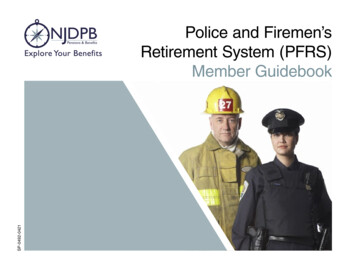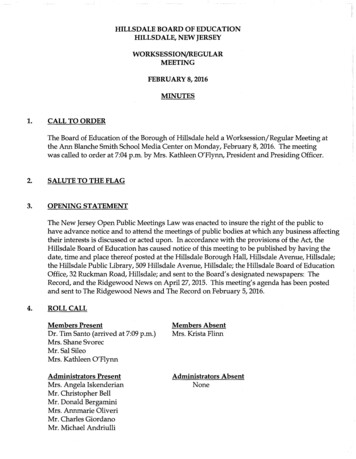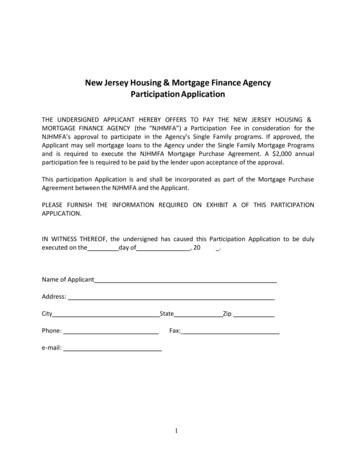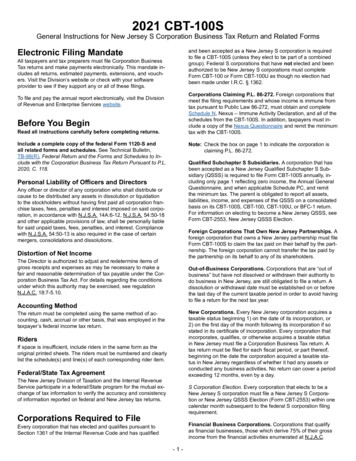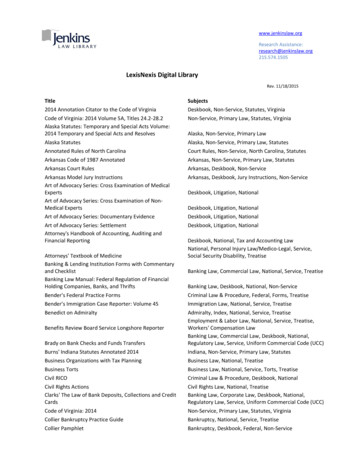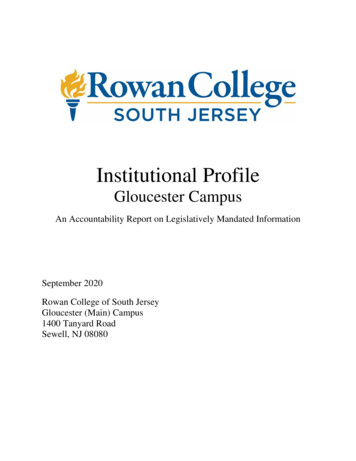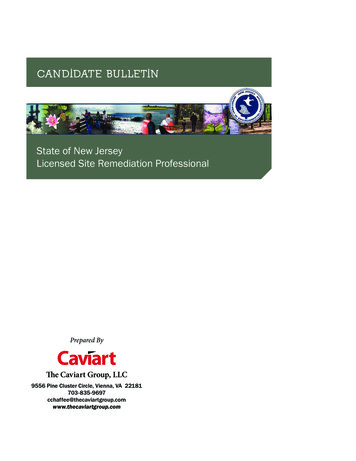
Transcription
CAN DIDAT E BU L LETINState of New JerseyLicensed Site Remediation ProfessionalPrepared ByThe Caviart Group, LLC9556 Pine Cluster Circle, Vienna, VA hecaviartgroup.com
TA BLE OF CON T E N TS1Introduction2About the Licensed Site Remediation Professional (LSRP) Credential2Trademarks and Copyrights2Statement of Non-Discrimination3Eligibility4-6Application Information6Examination Application Fee6Application Approval6Application Denial7-2178-11The ExaminationExam RegistrationAbout The LSRP Examination12-13Exam Appointment Cancellation of Rescheduling14-20On The Day of the Exam21Preparing for the Examination22-23LSRP Licensure24-29Appendix 1 - Excerpt from Site Remediation Reform Act, P.L. 2009, c.60.30Appendix 2 - Candidate Agreement
IN T RODUCTIONWelcome! Thank you for your interest in the New Jersey Licensed SiteRemediation Professional (LSRP) credential. By earning your license,you will have demonstrated your knowledge and competence in theidentification, evaluation, reduction, and elimination of environmentaland public health risks presented by contaminated sites in the State ofNew Jersey. You will be authorized by the State to oversee the remediationof contaminated sites in accordance with the New Jersey Departmentof Environmental Protection’s (NJDEP) applicable standards andregulations for responsible parties. You will be subject to strict ethicalstandards established by statute and regulation and must ensure thatremediations are protective of human health, safety and the environment.The conduct of LSRPs is overseen by the Site Remediation ProfessionalLicensing (SRPL) Board (Board).This Candidate Bulletin outlines the licensing process and containsinformation on registering for and taking the licensing exam. ThisCandidate Bulletin DOES NOT provide information regarding Licensurefees, renewals, suspensions, revocations, reinstatements or other pertinentinformation once your License has been issued. Please visit the SRPLBoard’s website at www.nj.gov/lsrpboard for more information.Note: The information contained in this document was current at the timeof publication. The rules and requirements pertaining to the licensingprocess are subject to change by the State of New Jersey. Candidates areadvised to check the NJDEP and SRPL Board web sites for the most currentinformation.The information on the NJDEP Site Remediation web site and the SRPLBoard web site supersedes the information in this bulletin. The NJDEP SiteRemediation Web Site can be found at http://www.nj.gov/dep/srp/ and theSRPL Board Web Site can be found at http://www.nj.gov/lsrpboard.1
A B OU T THE LIC ENS ED S ITE REMEDIATIONP ROFES S IONAL (LS RP) C REDENTIALThe Licensed Site Remediation Professional (LSRP) program was createdby New Jersey’s Site Remediation Reform Act (SRRA), P.L. 2009, c.60.The Act created a SRPL Board (Board). The NJDEP has contracted withThe Caviart Group of Vienna, Virginia to develop and administer thelicensing examination program.T RA DEMARKS AND C OPYRIGHT S“Licensed Site Remediation Professional” and “LSRP” are designationsassigned under law by the State of New Jersey. Individuals who earn theLSRP credential may use these designations as long as the license has notexpired, been suspended, revoked, or voluntarily relinquished. Use byunauthorized persons is subject to civil and/or criminal action.Examination materials and publications are copyrighted by NJDEP andThe Caviart Group, LLC and protected under U.S. law. NJDEP and TheCaviart Group aggressively enforce the appropriate use of its property, andunauthorized use may result in sanctions or other penalties as permittedby law.STAT E MENT OF NON-DIS C RIMINATIONThe State of New Jersey and The Caviart Group do not discriminateamong applicants, candidates or licensees on the basis of age, sex, race,religion, national origin, or marital status.2
EL IGIBI LIT YAll persons wishing to become a Licensed Site Remediation Professional must meet the followingstatutory requirements below: Please note that this is just a synopsis of the requirements andyou are encouraged to view additional information on the SRPL Board’s web site that can befound at http://www.nj.gov/lsrpboard .Education – All candidates must hold a bachelor’s degree or higher in natural, chemical orphysical science, or an engineering degree in a discipline related to site remediation, froman accredited institution of higher education.Experience – All candidates must have a minimum of eight years of full-time professionalexperience in the field of site remediation, of which five years shall have occurred in NewJersey and at least three years shall have occurred in New Jersey immediately prior tosubmission of the application. The NJDEP and/or the Board may allow applicants withrelevant advanced degrees up to two years of credit for professional experience, of whichone year of credit may be awarded for applicants who have earned a master’s degree in arelevant field of study and up to two years of credit may be awarded for applicants who haveearned a doctorate degree in a relevant field of study. Candidates must also have a minimumof 5,000 hours of relevant professional experience within the State of New Jersey over thefive years immediately prior to submission of the application that is of a professional gradeand character that indicates the applicant is competent to issue a response action outcome.Training – All candidates must have attended and completed the minimum environmentalhealth and safety education and training provided pursuant to 29 C.F.R. Section 1910.120no more than one year prior to submission of an application for a license pursuant to thissection and have attended and completed a course approved by the NJDEP and the SRPLBoard on the State’s rules and regulations concerning the technical requirements for siteremediation no more than three years prior to submission of the application.Background – Candidates must not have been convicted of, or pled guilty to, anenvironmental crime, any similar or related criminal offense under federal or state law,or any crime involving fraud, theft by deception, forgery or any similar or related offenseunder federal or state law; and must not have had a professional license revoked by anystate licensing board or any other professional licensing agency within the previous 10years.3
A PPLICATION IN FOR M ATIONPLEASE NOTE THAT THERE ARE TWO SEPARATE EXAMINATION APPLICATIONFORMS. PLEASE READ CAREFULLY TO DETERMINE WHICH FORM TO USE.You can also view Frequently Asked Questions (FAQs) which can be found athttp://www.nj.gov/dep/srp/srra/lsrp/LSRP Application FAQ.pdf1. LSRP Licensure Examination Application Form with Limited Credential ReviewExamination applicants who currently hold a Temporary LSRP License or Applicantswho are Reapplying for Licensure Examinations must use this form.An applicant who currently holds a valid Temporary LSRP License in the State ofNew Jersey or an applicant who is reapplying for Licensure examination after failingthe examination, must submit a LSRP Licensure Examination Application Form withLimited Credential Review, along with the applicable fee. Once your application has beenreviewed by the NJDEP, you will receive a notice from the NJDEP indicating whether ornot you qualify to sit for the examination. If your application has been accepted, you willbe provided with a Candidate Identification Number and an Examination AuthorizationNumber in the notice that will allow you to register for the examination one time.Note that applicants who have a valid Temporary LSRP license who are unsuccessfulat passing the examination may sit for up to two (2) additional examinations withina nine (9) month time period from the date the first examination is offered. A LSRPLicensure Examination Application Form with Limited Credential Review, along withthe application fee, shall be submitted each time the applicant reapplies within the nine(9) month time period. An applicant who does not pass the examination within the9 month time period may not apply to retake an exam for a period of at least one (1)year. After the one (1) year period is over, an applicant reapplying for Licensure will beconsidered a new applicant and must submit a LSRP Licensure Examination Applicationwith Full Credential Review.An applicant who holds a valid Temporary LSRP License for the Remediation ofUnderground Storage Tank Discharges Only, who is unsuccessful at passing the initialexamination, may sit for up to two (2) additional examinations within a nine (9)4
month time period from the date the first examination is offered. The LSRP LicensureExamination Application with Limited Credential Review, along with the applicationfee, shall be submitted each time the applicant reapplies within the nine (9) month timeperiod. An applicant who does not pass the examination within the 9 month time periodmay not apply to retake the Examination for a period of at least one (1) year, and untilall education requirements for permanent licensure are met.The LSRP Licensure Examination Application Form with Limited CredentialReview and instructions for the application can be found htm.2. LSRP Licensure Examination Application Form – Full Credential ReviewExam Applicants who do Not hold a valid Temporary LSRP License must use this form.An applicant who does NOT hold a valid Temporary LSRP License in the State ofNew Jersey is considered a first time applicant and must submit a LSRP LicensureApplication Form with Full Credential Review, along with the applicable fee. Once yourapplication has been reviewed by the NJDEP, you will receive a notice from the NJDEPindicating whether or not you qualify to sit for the examination. If your applicationhas been accepted, you will be provided with an Candidate Information Number and aExamination Authorization Number in the notice that will allow you to register for theexamination one time.Note that new applicants who are unsuccessful at passing the initial examination, may sitfor up to two (2) additional examinations but must submit a LSRP Licensure ApplicationForm with Limited Credential Review along with the applicable fee each time theyreapply to take the examination. Note that the two (2) additional examinations are notrequired to be taken within the nine month time frame that is applicable to TemporaryLSRP license holders. If a new applicant does not pass the examination after taking it amaximum of three times over four consecutive dates that the examination is offered, theapplicant may not reapply to take the examination for a period of at least one (1) year.After the one (1) year period is over, an applicant reapplying for Licensure must use theLSRP Licensure Application Form with Full Credential Review.The LSRP Licensure Examination Application Form with Full CredentialReview and instructions for the application can be found at5
m.EXA M I N AT I O N A P P LICAT ION FE EIf you are a first time applicant who does not have a Temporary LSRP License and aresubmitting the LSRP Licensure Application Form with Full Credential Review, thefee is 400.00. If you currently hold a Temporary LSRP License or are reapplying forexamination using the LSRP Licensure Application Form with Limited CredentialReview, the fee is 50.00.A PP LI CAT I O N A P P ROVA LUpon approval of the application NJDEP will contact all applicants in writing to informthem if their application has been accepted. Approval of the application does notguarantee licensure. A license will be issued only after NJDEP receives notification fromThe Caviart Group that the applicant has taken the LSRP licensing exam and received apassing score and any licensure fees that may be due from the applicant are paid to theNJDEP.A PP LI CAT I O N DE NIA LIf the application is denied, the NJDEP will contact the applicant in writing and explainthe reason(s) for the denial. If the applicant disagrees with the NJDEP’s decision, theapplicant must provide a written statement with an appropriate rationale. If the applicantchooses to resubmit the application, a new fee must accompany the subsequent application.Any written statements submitted in response to an application denial must be sent to:New Jersey Site Remediation Professional Licensing Boardc/o New Jersey Department of Environmental ProtectionSite Remediation ProgramLicensed Site Remediation Professional License ProgramP.O. Box 420, Mail Code 401-05ATrenton, NJ 08625-04206
T H E EX A M IN ATIONEXA M R E G I ST RAT IONOnce the NJDEP has determined an applicant meets the Education and Experiencerequirements to sit for the LSRP Licensing Examination, the NJDEP will send out anapproval notification letter which will provide candidates with the information neededto register for the licensure examination. This information will include a candidateidentification number and an examination authorization number. Candidates will alsobe provided with the internet address of The Caviart Group’s NJ LSRP ExaminationRegistration web site where they will complete the registration process.At the examination registration web site, candidates will enter the candidate identificationnumber and the examination authorization number provided by the NJDEP and willcreate a username and password. They will then be able to select an examination dateand testing location from those available. Examination administration locations willhave a specific number of spaces available for testing. Spaces for all examinations will beassigned on a first-come, first-served basis. If no more spaces are available for a candidateon the date or location of their choice, they will need to select an alternative date and orlocation from those available.Upon completion of registration, candidates will receive (via email) an authorizationto test letter, stating the date, time, and location of the scheduled examination as wellas directions to the exam site. Candidates should verify that all personal informationincluded in the authorization to test letter to ensure that it is correct. Any errors shouldbe communicated to NJDEP immediately.The information on the authorization to test letter MUST match the information onthe Government issued identification (see Step 4, page 15) presented at the testingcenter, otherwise candidates will be refused entry to the examination and will berequired to re-register for a future examination. This means you must use the nameexactly the way it appears on your Government issued Identification when filling outthe Licensure Application.IMPORTANT: Candidates must bring their authorization to test letter e-mailed to themby The Caviart Group to the testing site on the day of the test.7
A B O U T TH E LSRP E XA M INAT IONFormatThe LSRP examination is a paper-and-pencil multiple choice format examination.Candidates will be presented with a printed test booklet and a separate printed answersheet. Candidates will record their answers by using a number 2 pencil to fill in the“bubble” or circle that corresponds to their intended answer. Candidates must take careto ensure that the bubble corresponding to their intended answer is completely filled.Only one answer can be indicated for each question. Candidates may change theirintended answer by erasing one bubble and filling in another bubble. Candidates mustbe certain to completely erase unintended answers. If there appear to be two or moreanswers to a question or it is unclear as to the intended answer, the question will becounted as incorrect.While candidates may make marks or notes in the examination booklet, all answers mustbe recorded on the answer sheet. Answers marked in the examination booklet will not becounted.There are 165 multiple-choice items on the NJ LSRP examination. Each item will presenta question to be answered along with four answer choices. Candidates should read eachquestion carefully, including all of the answer choices options and then select the answerchoice that BEST responds to the question.All examination items are of equal weight. Examinations are scored based on the numberof correct responses and there is no penalty for incorrect answers. Candidates shouldanswer all of the questions presented.TimeCandidates will be allowed 3.5 hours to complete the examination. Restroom breaksare allowed, but candidates will not be given extra time on the exam to account for anybreaks taken.Examination ContentThe LSRP examination addresses the knowledge, skills and abilities required to practicesite remediation in the State of New Jersey at the level required to protect the health,safety and welfare of the public. The content of the examination was defined through ascientific study known as a Job/Task Analysis (JTA). This process is in accordance with8
the accepted testing best practices and accreditation standards. The JTA process is thepreferred method of defining appropriate test content in a legally defensible manner.The JTA process included a panel of experts in site remediation from the State of NewJersey as well as a state wide survey of all professionals holding a temporary LSRP.The test consists of items that address the following domains and sub-domains. Domainsare major areas of practice and subdomains are the specific important tasks within thatdomain.Examination OutlineDefine the Objectives of the Project (3% to 5%) Ascertain client’s business goals and objectives Determine the applicable regulatory framework for a projectInformation Gathering (25% to 40%) Review and evaluate the existing body of evidence and identify information that ispertinent to the required remediation Review and interpret government files Review aerial photography of the site Review historical fire insurance company maps Interpret client files Identify and interview persons who are knowledgeable about current and previoususes of the site Identify regulations that apply to the project Perform site inspection to identify characteristics of known or potential areas ofconcern Perform area reconnaissance to determine the extent of area to be investigated orremediated Assess visual evidence of areas of concern, potential migration paths, potentialreceptors, and prior investigations/remediation Assess potential off-site sources of contamination Assess potential impact of operational processes for releases of hazardousmaterial Assess potential locations for sampling Evaluate topography, drainage, soil types, etc. Identify potential logistical/physical restraints to sampling Compile data and field inspection information9
Perform Initial Analysis (5% to 10%) Synthesize data to identify areas of concern Develop an initial conceptual site model including probable type(s) ofcontamination, its sources, pathways and receptors, and physical properties ofcontaminants Determine areas of concern to investigate Determine media to be tested including procedures, locations, depths, quantity,and analytesDevelop Project Plan (10% to 15%) Develop a quality assurance project plan (QAPP) Develop sampling and analysis plan as part of QAPP Develop quality assurance/quality control procedures for field sampling as part ofQAPP Develop health and safety protocols (HASP) for working on the site Develop implementation schedulePerform Site/Remedial Investigation (15% to 20%) Manage, direct and/or oversee the implementation of the sampling plan Provide on-site supervision of project implementation Evaluate actual field conditions and modify the plan to address unexpected siteconditions Perform regulatory reporting and public notification when required Evaluate usability of laboratory data Evaluate field data Determine if investigation is complete or if additional investigation isrequired Prepare and submit site/remedial investigation reportSelect Remedial Action (10% to 15%) Assess the feasibility of various remedial options Determine remedial data required Select preferred remedy Prepare remedial action work plan Develop cost estimate for remediation funding10
Perform Remedial Action (7% to 12%) Secure appropriate permits Manage, direct and/or oversee the implementation of the remediation plan Assess effectiveness of the remedial action Issue Response Action Outcome (RAO)Perform Post Closure (3% to 5%) Prepare long-term monitoring plan Prepare remedial protectiveness certification of the remedyTesting Center LocationsThe LSRP examination will be administered on several specific days each year. Testinglocations will be at various sites within the State of New Jersey. The dates and locations ofupcoming test administrations will be posted on the NJDEP web site and on The CaviartGroup’s examination registration web site.Special AccommodationsThe State of New Jersey and The Caviart Group comply with the Americans withDisabilities Act (ADA), and are dedicated to ensuring that no eligible individual isdeprived of the opportunity to take the exam solely by reason of a disability as definedunder the ADA, as long as the disability is not one which would render the individualincapable of performing the duties of the licensed professional.Applicants needing special accommodations must make a request in writing at least two(2) months in advance of the desired testing date. Requests must include documentationof a formally diagnosed ADA-recognized disability from a qualified professional who hasprovided evaluation or treatment to the applicant within the past year.11
EXA M A P P OI NT M E NT CA NCE LLAT ION OR RES C HEDULINGEmergency CancellationA candidate who encounters a medical or other emergency which makes it impossiblefor him or her to sit for the examination on the scheduled date should notify NJDEPimmediately in writing (email is acceptable). The candidate must provide a writtenstatement detailing and attesting to the medical or other emergency that prevented himor her from testing.The NJDEP and/or the SRPL Board will assess the circumstances of the emergency andmake a determination as to whether the candidate will be allowed to re-schedule to betested without additional fees. The decision of the NJDEP and/or SRPL Board on thismatter is final.Acceptable emergency situations include: The death of an immediate family member. An accident, illness, or hospitalization of the candidate (must be verified by a doctor) A natural disaster.Please send an e-mail to Wayne Howitz at Wayne.Howitz@dep.state.nj.us to notifyNJDEP in the event of an emergency or send a written notification to:New Jersey Site Remediation Professional Licensing Boardc/o New Jersey Department of Environmental ProtectionSite Remediation ProgramLicensed Site Remediation Professional License ProgramP.O. Box 420, Mail cod 401-05ATrenton, NJ 08625-0420WithdrawalIn a non-emergency situation, a candidate who finds that he or she is unprepared orotherwise unable to sit for the examination on the scheduled date should notify NJDEPimmediately in writing (email is acceptable).If the cancellation is received at least 15 days before the scheduled date, the candidate willbe allowed to reschedule for a future examination without additional fees (as long as thetime allowed for testing by the NJDEP and/or the SRPL Board has not expired).If the cancellation is received with less than 15 days’ notice, or if the candidate simply fails12
to appear for the examination without advance notice, the candidate will be required toapply to retest and pay the examination fee again in order to sit for it in the future.Please send an e-mail to Wayne Howitz at Wayne.Howitz@dep.state.nj.us to notifyNJDEP of a withdrawal or send a written notification to:New Jersey Site Remediation Professional Licensing Boardc/o New Jersey Department of Environmental ProtectionSite Remediation ProgramLicensed Site Remediation Professional License ProgramP.O. Box 420, Mail cod 401-05ATrenton, NJ 08625-042013
ON TH E DAY OF T HE E XA MStep 1: Arrive at the Test Center EarlyYour exam appointment confirmation letter will provide you with the location of yourtesting center. Plan your travel carefully so that you will arrive at the test center at least 20minutes before the scheduled appointment time. This time is necessary for candidates tocomplete the examination check-in process and for examinations to be distributed beforethe scheduled test starting time. If you arrive at the test center less than 10 minutes beforeyour scheduled appointment, you may be denied access to the test center and considereda “no-show.”In no case will you be admitted to the test if you arrive after the scheduled test startingtime.If you are considered a “no-show,” your registration will be voided, you will forfeit yourexam registration fee, and you will be required to apply to retest and pay the examinationfee again in order to sit for it in the future.Step 2: Bring Your Authorization to Test Letter with YouYou MUST bring the your “Authorization to Test” notification that you received viae-mail from the Caviart Group.Step 3: Check-In for Your TestDo not bring personal items or unauthorized items with youEach room will be equipped with a clock to gage time and Number 2 pencils with eraserswill be provided. You should not bring any personal items with you to the test centerother than your identification. If you do bring personal items to the test center, the centeradministrator will show you where to store your personal items, however there will not bea secure storage area for your personal items. You may not have any personal items withyou in the testing room.Neither test center personnel, NJDEP nor The Caviart Group will be responsible for lostor stolen items.The LSRP examination is a closed book examination. Candidates may not bring anyreference material with them to the test. If required, reference material will be providedby the proctor.14
The following items are considered “unauthorized materials”: Books or other reference materials, except as provided by the proctor Papers of any kind, except as provided by the proctor Photographic or image-capturing or copying devices»» Communication devices of any kind, including pagers, cell phones, PDAs, etc.»» Electronic devices of any kind, including laptops, iPads, recording devices, etc. Purses, briefcases, backpacks, or other personal items Clocks or Alarms Food or beverages (water will be available)Step 4: Present Acceptable Personal IdentificationNJDEP and The Caviart Group employ very strict testing security measures. One level ofsecurity involves your identification. You must bring at least one form of a Governmentissued photo identification that meets the following requirements:Your identification (ID) must: Contain your name exactly as you provided it during the exam registration process(as it appears on your “Authorization to Test” letter); Have a permanently affixed photo of your face; Be current — expired IDs will not be accepted; Be an original document — no photocopies will be accepted;Examples of Acceptable forms of identification are: Government-issued driver’s license (must have photo) or photo ID; Passport Military ID (except those with chips) Permanent resident visaUnacceptable forms of identification include: Employee identification or work badge; University/college identification;If you do not present acceptable identification, you will not be allowed to take your examand you will be considered a “no-show” even though you appeared at the exam site. Yourregistration will be voided, you will forfeit your exam registration fee, and you will berequired to register and pay for that exam again in order to sit for it in the future.15
The test administrator will verify that the name on the identification matches the nameon the exam registration and that the photo is of you. You must keep this identificationwith you at all times during the exam.Step 5: Sign the Candidate AgreementYou must sign the NJDEP Candidate Agreement (see Appendix 2) indicating agreementto the testing process and to maintain confidentiality in regard to testing materials. Thisform will be provided to you upon arrival at the testing center and is not necessary for youto bring the form provided in this Bulletin.If you do not sign this form you will not be allowed to take the examination and you willbe considered a “no-show” even though you appeared at the exam site. Your registrationwill be voided, you will forfeit your exam registration fee, and you will be required toregister and pay for that exam again in order to sit for it in the future.Step 6: Do Not Bring Any Food or Drink with YouYou will not be allowed to bring any food or drink into the testing room. (Water will beprovided in the test room but must be consumed at the water station.)Step 7: Take Your Assigned SeatOnce admitted to the testing room, candidates will be provided with a test booklet and anassigned seat. You must sit in your assigned seat and remain quiet until the test begins.DO NOT OPEN THE TEST BOOKLETUNTIL YOU ARE INSTRUCTED TO DO SO.Step 8: Listen to the InstructionsListen carefully to the instructions given by the proctor and read all directions thoroughly.Proctors cannot discuss or answer questions concerning the content of the exam.Step 9: Use your Testing Time WiselyCandidates are encouraged to pace themselves to ensure that they have time to respondto all of the questions in the test. The proctor will advise you when there is 30 minutesremaining, 15 minutes remaining and when there is 5 minutes remaining in the test.When the proctor indicates that the testing time is over all candidates must immediately16
put down their pencils. Any candidate who continues to mark answers after the test hasended will be disqualified and test results will be voided.If you complete the test before the time is called you may check out of the test s
reviewed by the NJDEP, you will receive a notice from the NJDEP indicating whether or not you qualify to sit for the examination. If your application has been accepted, you will be provided with a Candidate Identification Number and an Examination Authorization Number in the notice that will allow you to register for the examination one time.
